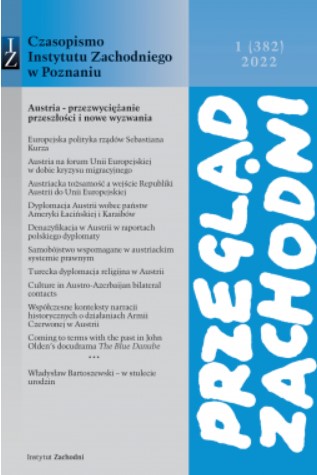Against political compromises – coming to terms with the Austrofascist and National Socialist past in John Olden’s docudrama The Blue Danube (1965)
Against political compromises – coming to terms with the Austrofascist and National Socialist past in John Olden’s docudrama The Blue Danube (1965)
Author(s): Jakub GortatSubject(s): Political history, Government/Political systems, Post-War period (1950 - 1989), Fascism, Nazism and WW II, Film / Cinema / Cinematography, Politics of History/Memory
Published by: Instytut Zachodni im. Zygmunta Wojciechowskiego
Keywords: docudrama; Austrofascism; coming to terms with the past; Austrian history; National Socialism;
Summary/Abstract: An der schönen blauen Donau (The Blue Danube), written by Hellmut Andics and Franz Hiesel and directed by John Olden in 1965, may be viewed as a groundbreaking television docudrama in Austria for two reasons. Firstly, it offered a new, hybrid form called ‘docudrama,’ which combined elements of a documentary film with the features of a fiction film. Secondly, in the context of the Austrian culture of remembrance, the film was astonishing in that its narrative boldly dealt with topics considered taboo at a time of an informal consensus between the two major political parties: the ÖVP and the SPÖ as well as their successors, the CSP and the SDAP. In line with this consensus, no mention of the antagonism between the conservatives and socialists during the authoritarian rule of Chancellors Dollfuß and Schuschnigg was made in the public discourse, instead, both parties claimed to have been victims of the Nazi terror (the so called “camp street” myth – Mythos der Lagerstraße). An der schönen blauen Donau significantly infringes this consensus, showing the persecution of socialist activists by the Austrofacist regime and the downplaying of the activity of the underground Nazis in Austria (the so called illegale Nazis). Embedded in the context of the Austrian post-war culture of remembrance, the paper analyses the teleplay’s narrative, paying special attention to selected characters representing three political movements in Austria: the socialists, the conservatives and the Nazis. Film narration analysis is the principal research method applied in the paper. Its last section also examines the reception of the docudrama and its problematic distribution.
Journal: Przegląd Zachodni
- Issue Year: 382/2022
- Issue No: 01
- Page Range: 185-202
- Page Count: 18
- Language: English

